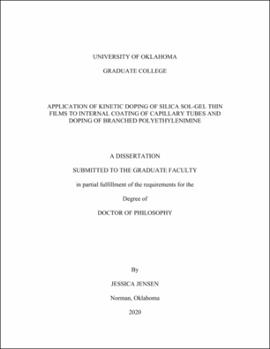| dc.description.abstract | The applications of kinetic doping in silica sol-gel thin films are a mostly under-developed area. Previously, our lab has demonstrated a high loading capacity for cationic dye and protein guest molecules in silica thin films coated on flat-surface coverslips. Expanding on this work, we hypothesized that doping of films internally on capillary tubes was possible, with the aim of developing protocols for loading enzymes on these substrates. Such devices could be very useful for biocatalysis in microfluidic devices. Additionally, we theorized that branched polyethylenimine (BPEI) could be loaded into a silica thin film with kinetic doping. An organic molecule with a cationic charge at neutral pH, BPEI was a good candidate for kinetic doping and could not be loaded via traditional methods. Loading of BPEI could produce films and coatings that are useful in heavy metal remediation or inhibition of biofilm formation.
In chapter three, kinetic doping is applied to loading internally coated capillary tubes. Parameters for internally doping capillary tubes were developed with rhodamine 6G, producing internally coated thin films with approximately 90 nm thickness. Horseradish peroxidase (HRP) was loaded into the thin films, with a 47000X increase in concentration over the loading solution. Activity of the loaded HRP was determined to be 0.019 ± 0.003 U/mg, and it was shown to have a stronger resistance to denaturation by methanol than surface-adsorbed HRP.
In chapter four, kinetic doping was utilized to functionalize silica thin films with 25000 MW BPEI. To our knowledge, this is the first time that a highly basic guest such as BPEI has been doped into silica thin films. Parameters for the kinetic doping of 1800 and 750000 MW BPEI into silica sol-gel thin films were developed in chapter 5. Solvent accessible amines were quantified: 25000 and 750000 MW BPEI doped films were found to have similar amounts of amines while 1800 MW BPEI doped films had significantly less. SEM images of the films revealed drastic morphology differences between the films.
Two applications of these films were tested. The 25000 MW films were tested for copper (II) sequestration to assess their potential for heavy metal sequestration, and showed high loading capacity of 10 ± 6 mmol/g. They proved to be reusable, with only a 6% reduction in the amount of copper (II) ions sequestered by the third use. The films were also stable against leaching over the course of one week in solution, with less than 1% of the original BPEI lost under various storage conditions. The efficacy of the 1800, 25000, and 750000 MW films against S. epidermis biofilms were tested with a crystal violet assay, and all films proved to be effective in inhibiting biofilm formation (p-value < 0.05). The best dopant, 25000 MW BPEI, caused an 89% reduction in biofilm growth and surpassed the performance of the clinical antibiotic gentamycin (p-value < 0.003).
Most of the results in chapters three and five are pending publication at this time. Most of the results in chapter four have been previously published in 2019 in ACS Omega (Jensen, J. M.; Yip, W. T., Amine Functionalization of Silica Sol–Gel Thin Films via Kinetic Doping: A Novel, Green Approach. ACS Omega 2019, 4 (20), 18545-18554.). | en_US |
